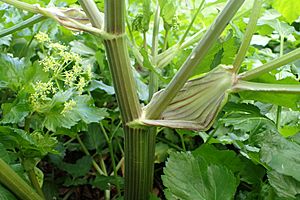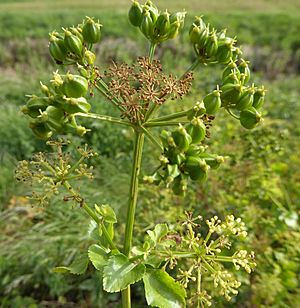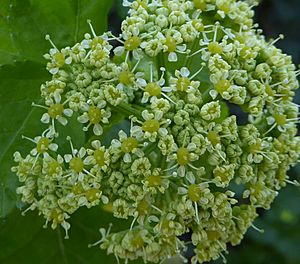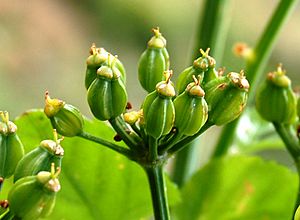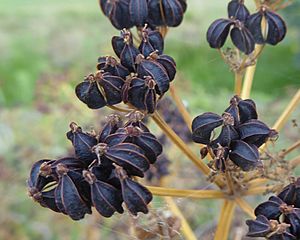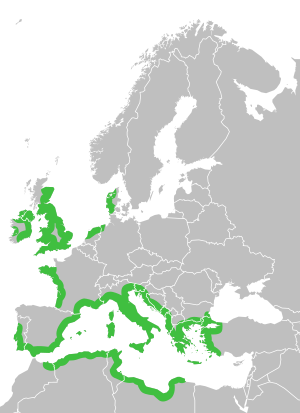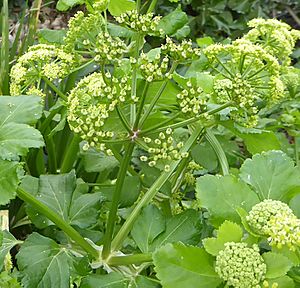Smyrnium olusatrum facts for kids
Quick facts for kids Smyrnium olusatrum |
|
|---|---|
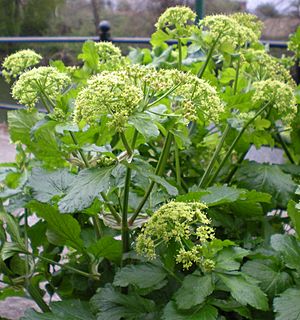 |
|
| Scientific classification | |
| Genus: |
Smyrnium
|
| Species: |
olusatrum
|
Alexanders (also called alisander) is an edible plant that grows flowers. It belongs to the Apiaceae family, also known as the carrot family. This plant grows in wild areas and along hedges near the Mediterranean Sea and Atlantic Ocean coasts in Europe. People used to grow it widely as a vegetable for cooking. Today, it is mostly gathered by people who look for wild foods.
Contents
What Alexanders Looks Like
Alexanders is a strong, hairless plant that grows for two years (a biennial). It can reach up to 150 cm (about 5 feet) tall, sometimes even 180 cm. Its stem is solid when young, but becomes hollow and grooved as it gets older. The stem can be up to 22 mm wide.
The plant has a thick main root, like a carrot, which can be 60 cm (about 2 feet) long. It also has smaller, thin roots branching off.
The leaves on the stem grow in a spiral pattern. However, the upper leaves often grow opposite each other or in groups of three. The leaf stalks, called petioles, are swollen and have purple stripes. They have thin, papery edges near the bottom. The main leaves are broadly diamond-shaped and are divided two or three times into smaller sections. Sometimes, they have a few hairs near their base. The small leaf parts are dark green on top and pale green underneath. They are flat, have rounded lobes, and jagged edges with tiny white tips called hydathodes.
The flowers grow in clusters at the top of the plant or where leaves meet the stem. These clusters are called "umbels of umbels." Each main cluster is about 6-7 cm wide and has 5 to 25 stalks, called rays. These rays are smooth, ridged, and 2-4 cm long. There are usually 3-4 small, pale, and hard-to-see leaves (bracts) at the base of the main cluster, or sometimes none. The main stalk (peduncle) is usually longer than the rays.
Each smaller cluster (umbellet) is 10-20 mm wide and has 10-20 flowers. There are 1-5 tiny leaves (bracteoles) at the base of these smaller clusters. The flowers are small and have a star-like shape (actinomorphic). They have 5 yellowish petals and 5 tiny green sepals. Each flower has 5 stamens (male parts) and, if present, 2 styles (female parts).
Sometimes, there are 4 or 5 stalks branching from the top of the stem, making it look like many layers of flower clusters. Usually, only the main cluster at the very top has flowers with both male and female parts. The side clusters have both male-only and male-and-female flowers. The smallest clusters often have only male flowers. You can see this best when the plant is mature, as the male-only flowers will wither without making fruit.
The mature fruit is black and about 6.5-8 mm long. It splits into two single-seeded parts called mericarps. A small stalk, called a carpophore, runs between these two parts. Each mericarp has 3 ridges and many oil tubes (vittae). These tubes release a strong-smelling oil that can smell like capsicum (peppers) or diesel fuel. A single alexanders plant can produce between 3,000 and 9,000 seeds in one year.
Plant Family and Naming
Alexanders, or Smyrnium olusatrum, belongs to a large group of plants within the carrot family called Apoideae. Plants in this group usually have leaves that are divided many times, no small leaf-like structures at the base of the leaf stalks (stipules), and flowers arranged in compound umbels. They also have a special swollen base to their styles (stylopodium) and fruits with a thin inner layer (endocarp) and oil tubes (vittae).
The famous scientist Carl Linnaeus gave the plant its scientific name in 1753. Its name has stayed the same since then. The name "Smyrnium" comes from the Greek word for myrrh. The second part of the name, "olusatrum," was a Roman name for a plant, meaning "herb" (olus) and "black" (ater). The English name, "alexanders," is a changed version of the Latin "olus ater" and has nothing to do with Alexander the Great.
This plant has many other common names, including allsander, alshinder, alick, skit, skeet, hellroot (which might mean "heal root"), megweed, wild parsley, Macedonian parsley, wild celery, horse celery, stanmarch, and black lovage. In Italy, it's often called macerone, and in Greece, it's known as agrioselino (wild celery).
How to Identify Alexanders
It's usually easy to recognize alexanders in northern Europe. Its compound leaves, which are divided into three parts, are very unique, as are its yellow flowers. In the wild, you might confuse it with hemlock water-dropwort or wild celery, but those plants have white flowers. A garden herb called Lovage looks similar with its dark, shiny leaves, but lovage has more sharply toothed leaves, no milky sap in its leaf stalks, and grows more upright.
Where Alexanders Grows
Alexanders is common in Great Britain, especially in coastal areas in the south. It becomes less common as you go north into Scotland. It doesn't grow in Orkney or Shetland. It's a lowland plant, meaning it doesn't grow very high up, usually no higher than 290 meters (about 950 feet) in Cornwall. Away from the coast, it's often found near old medieval monastery gardens and other historic places like castles. In Ireland, it's common along the south and east coasts but rare inland and in the west.
In Europe, it grows all around the Mediterranean Sea, including the islands, and extends as far as Crimea and the Black Sea. It's also found along the Atlantic Ocean coast from the Iberian Peninsula north through France, Belgium, the Netherlands, Denmark, and recently into Norway. It also grows west to the Azores. In north Africa, it's found in the Mediterranean and Atlantic regions, including the Canary Islands.
Alexanders has also been introduced to new places like New Zealand, Australia, and Bermuda.
Where Alexanders Lives and How it Interacts with Nature
In Britain and northern Europe, alexanders mainly grows in tall grasslands, often along roadsides and at the edges of forests. It likes areas where the soil has been disturbed a bit at first. But once it starts growing, it can take over and prevent most other plants from growing. It prefers damp, moderately fertile soils that are neutral to slightly chalky, often in light shade. Even though it's more common near the coast, it doesn't like salt. Its presence there might be more because of the milder temperatures near the sea.
In the Mediterranean, it also grows in areas with bare ground, but you can also find it in phrygana (a type of shrubland), olive groves, and orchards.
The flowers of alexanders have a pleasant smell and attract many different insects. This is because the stylopodium, the swollen base of the flower, produces a lot of nectar that insects can easily reach. In Britain, over 150 types of insects have been seen visiting the flowers. These include many flies, bees, several beetles, butterflies and moths, and other insects.
Alexanders plants are often infected by a fungus called "alexanders rust" (Puccinia smyrnii). This fungus causes orange or yellow bumps on both sides of the leaves and makes the stems thicker. Later, dark brown spots appear only on the undersides of the leaves.
The UK database of insects that eat plants lists seven species that feed on alexanders. These include a beetle, three types of aphids (small insects that suck plant sap), and a fly called the celery fly. There are also two types of small moths.
History of Alexanders
People often believe that alexanders is the herb that the ancient Greek doctor Pedanius Dioscorides called Hipposelinum, and which the Romans called olusatrum. In the late 1500s, William Turner wrote that this was what his teachers believed. However, after reading Dioscorides's writings, Turner realized that the English alexanders was not the same as Dioscorides's Smyrniū, because that plant had paler leaves, a purplish color, and a white root. It seems that smyrnium and olusatrum were originally different plants that later herbalists confused.
This confusion continued for many years. In the mid-1600s, Nicholas Culpeper wrote that "alisander... is sold in apothecaries' shops as Macedonian parsley-seed." He also noted that it was grown in "all the gardens in Europe, and so well known, that it needs no farther description." John Ray explained in 1660 that alexanders was called that because in Italy and Germany it was known as herba alexandrina, as people thought it came from Alexandria.
Many writers say that alexanders is native to the Mediterranean region and was only brought further north later. However, some experts say there isn't much proof for this. The oldest find of alexanders in Britain is a seed found at a Roman site. This might be because its pollen, which usually helps find old plant evidence, is hard to identify. Because of this, and from reading Dioscorides, people often say the Romans introduced it. But some authors believe it is native to Britain.
The first written record of alexanders growing wild in Britain was by Turner in 1562. He wrote that "Our Alexander groweth... in islands surrounded by the sea between the far part of Somersetshire and Wales." This place might have been Steep Holm, an island where another biologist, John Lightfoot, also saw it in 1773.
Uses of Alexanders
Alexanders was once highly valued in northern Europe as an early vegetable. It was one of the few fresh plants that could be eaten in February or March. In western Britain, sailors believed it could "clear the blood" and cure scurvy (a disease caused by lack of vitamin C). In Dorset, it was known as "helrut," which might mean "heal root." The seeds were also used to treat scurvy.
A text from the 1600s describes young alexanders shoots being used in salads or a "spring pottage" (a thick soup). An early 1700s recipe from Ireland for Lenten Potage included alexanders, watercress, and nettles. In Turkey, where it's called Baldiran or Göret, the young shoots and leaves are cooked and eaten with yogurt, or eaten fresh in salads. The roots are also eaten, either cooked or fresh. Many people think the roots are the best part. They are dug up in winter when they are thickest. However, in Britain, it is illegal to dig up wild plants without permission.
The young leaves taste like a mix between celery and parsley. The seeds have a sharp, peppery taste. Alexanders became less popular in the 1700s after celery started to be grown in large amounts, replacing wild herbs and vegetables. It's not commonly used as food today, but it has found some new use in special "foraged" food recipes and restaurants. It is also fed to farm animals.
In the 1800s, bundles of alexanders stalks from Steep Holm island were used as fuel for fires.
Many writers claim that alexanders seeds smell like myrrh, probably because of the name Smyrnium. However, there are no documented reports of it being used as myrrh. Studies have found many fragrant compounds in different parts of the plant, but none are currently taken out for commercial use.
See also
 In Spanish: Apio caballar para niños
In Spanish: Apio caballar para niños


